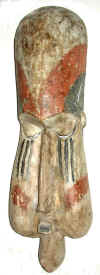 |
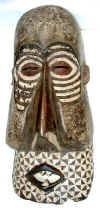 |
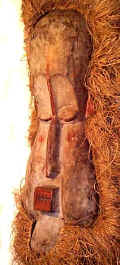 |
||
 |
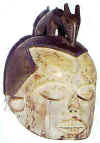 |
|||
 |
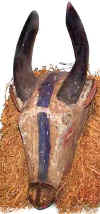 |
TRIBAL AFRICAN ART
Democratic Republic of the Congo
The 80,000 Suku people have lived in
the southwestern part of the Democratic Republic of the Congo since the 16th century.
Their main economic resource is farming. Cultivation of yams,
manioc, and groundnuts is done primarily by women. This is supplemented by the men hunting
with dogs in the surrounding forest and by the women gathering wild berries, nuts, and
roots. Occasional fishing in the Kwango River also provides some food. Although hunting
rarely provides substantial quantities of meat to the Suku diet, it is considered an
important part of male culture. Palm tree plantations provide the Suku with palm oil, an
important commodity for local and international trade.
The wood sculpture is a royal court
art linked to the social hierarchy. The statues that contain magic ingredients have
malevolent or beneficial functions. The medications are placed in the figure’s
abdomen, which is closed up with a resin stopper, or enclosed in small bags hung around
the neck or waist. The statue is kept in a hut that stands with in the enclosure of the
chief’s house. The Suku of the north have statues, the mulomba: these have one hand outstretched to
solicit a gift. The sculptures wear the hairdo typical of the chiefs of the territory and
lineage. The Suku also carve figures, which are used during fertility ceremonies and
kneeling or crouching fetish figures. These are used either as ancestor figures or as the
personification of the evil spirit.
The Suku have an initiation, the n-khanda. A special hut is built in the forest to give shelter to the postulants during their retreat; the event ends in circumcision, an occasion for great masked festivities including dances and song. The masks fulfill several functions: some serve as protection against evil forces, others ensure the fertility of the young initiate. Their role consists in frightening the public, healing the sick, and casting spells. The charm masks of the initiation specialist do not "dance." Their appearance must engender terror, especially the
kakuungu, with its swollen cheeks, massive features, and protruding chin. The Suku also used hemba helmet masks. These are cut from a cylinder of wood, the hairdo often surmounted by a person or animal. These masks are supposedly an image of the community of deceased elders, notably the chiefs of the maternal lineage. They are used to promote success in the hunt, to heal, and to punish criminals. They were also worn by dancers during certain initiation ceremonies.